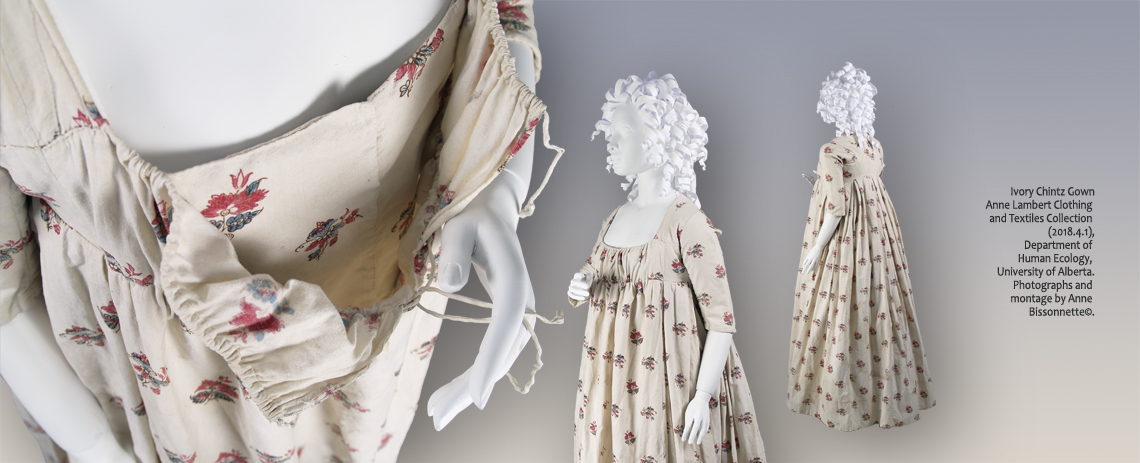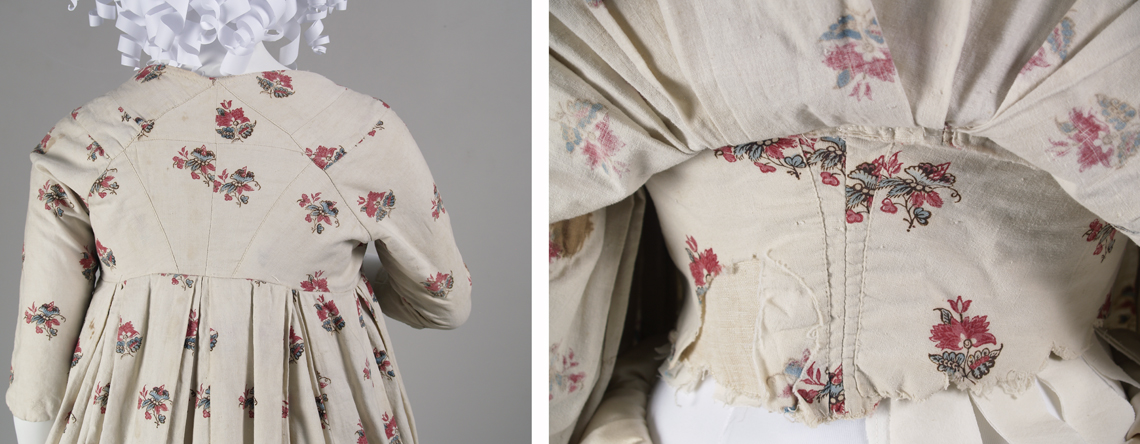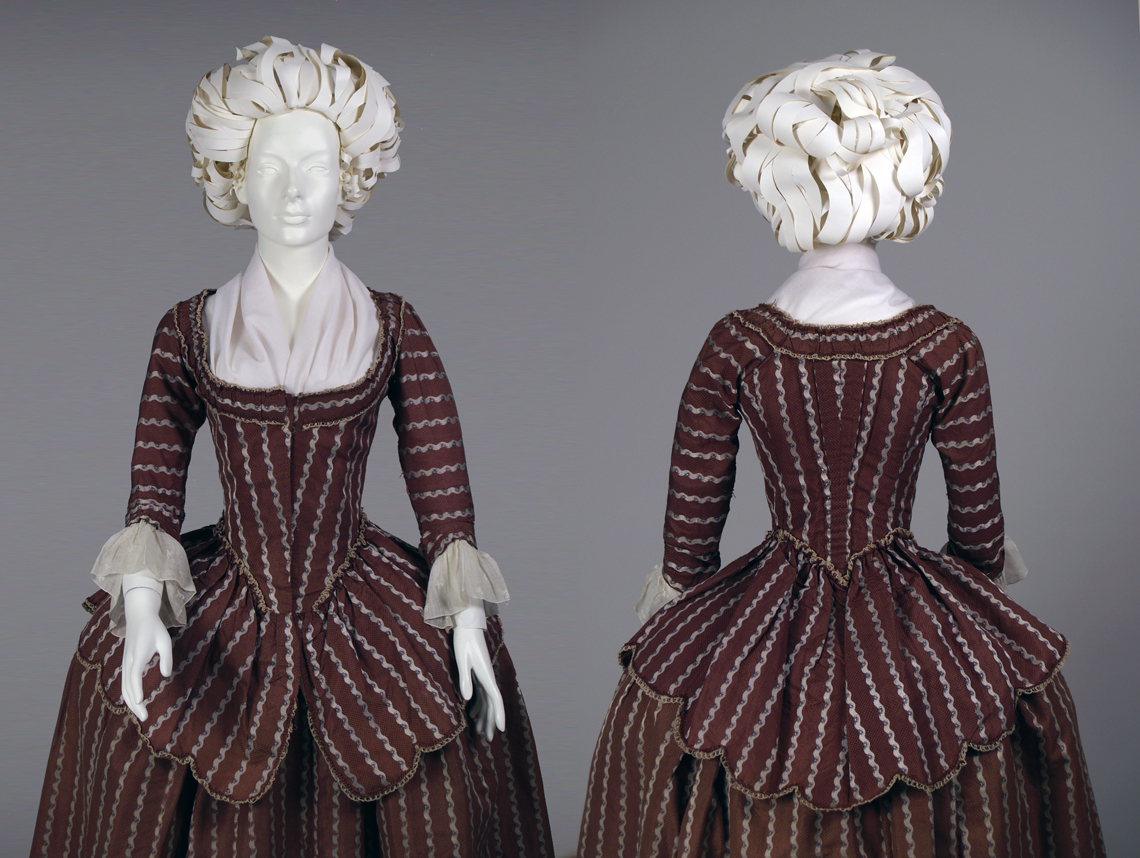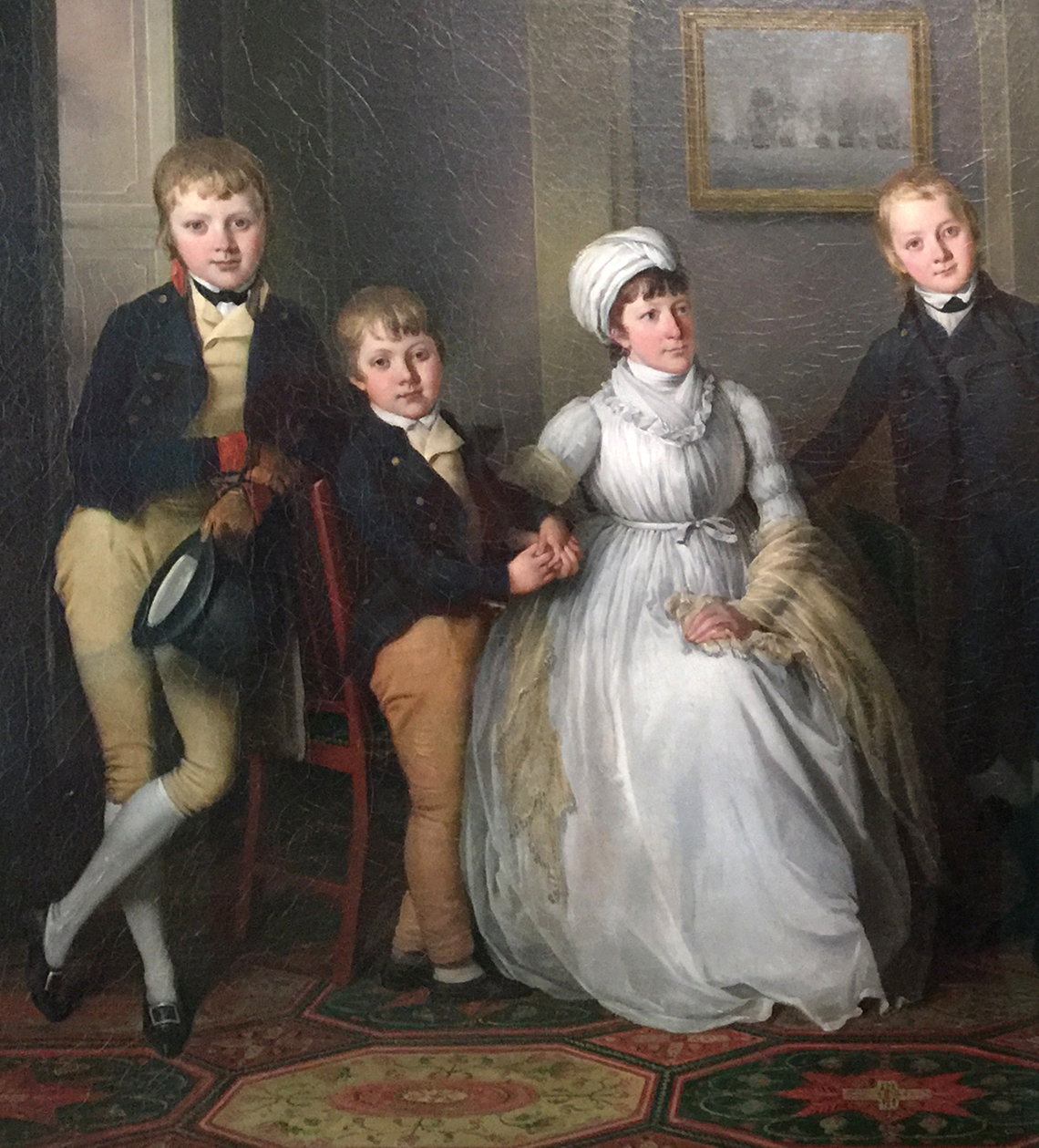
DRESS & ESCAPISM - THE DRESS RESEARCH EXHIBITION SERIES
Part 1 of 3: Dress Artifacts & Curatorial Practices
A Virtual (and Evolving) Exhibition
Anne Bissonnette, Lead Curator
Josée Chartrand and Katelin Karbonik, Contributing Curators
June 30, 2020 – June 30, 2021
Part 1 Home | The Blair Suit Reproduction | The Robe à la Française Reproduction | The Mid-1790s Chintz Gown | The Chemise Dress | The 1796 Reproduction Wedding Gown | The Housemaid's Dress
Round gown
Unknown maker, may be American from English block-printed cotton, first made in the 1780s and altered in the mid-1790s.
Cotton plain weave, cotton or linen lining
Anne Lambert Clothing and Textiles Collection, Department of Human Ecology, University of Alberta
Purchased (2018.4.1)
Paper hair by Emily Graca and Anne Bissonnette
Mount, photographs, and montage by Anne Bissonnette©
University of Alberta Master student Katelin Karbonik selected this garment for a term paper in 2019. Observing the materiality of the gown, she focused on the textile and on the altered state of the gown. Like the Blair suit mentioned previously, the fabric of this garment was an excellent way to examine global trade, most particularly the trade in printed cotton fabrics between India, Europe, and colonial territories in America. Deemed exotic due to their Indian origin and beloved for their unique aesthetics and colourfastness, printed cotton “chintzes” were in such high demand that bans were enacted to protect European manufacturers well into the mid-18th century.[1] The yearning and appreciation for chintzes continued, which may explain the cleaver alterations seen in this gown.
The presence of a longer bodice under the skirt portion (Figures 1 and 2) demonstrates the re-use of an earlier gown with stitched back pleats—often referenced as a style à l’anglaise (Figure 3)—to update the gown to emerging neoclassical taste. The cut of the gown was also of interest to Karbonik’s supervisor, Dr. Anne Bissonnette, as it is an excellent demonstration of a transitional silhouette that is often misunderstood as a linear “Empire” style, dues to its elevated waistline. Despite the high waist, the skirt remains voluminous and the torso compressed in conventional conical stays. Mounting the gown for display thus helped to assess the amount of petticoats the gown needed and the lack of breast delineation at the torso.

Figures 1 and 2
Chintz gown, details
Unknown creator, may be American from English block-printed cotton, first made in the 1780s and altered in the mid-1790s
Cotton plain weave, cotton or linen lining
Anne Lambert Clothing and Textiles Collection, Department of Human Ecology, University of Alberta
Purchased (2018.4.1)
Paper hair by Emily Graca and Anne Bissonnette
Photographs by Anne Bissonnette©

Figure 3
Brown striped silk caraco (jacket) and petticoat
Unknown creator and place of origins, ca. 1780
Silk brocade, linen lining, silk tape, cotton plain weave sleeve ruffles
Anne Lambert Clothing and Textiles Collection, Department of Human Ecology, University of Alberta
Purchase (2014.1.4 a,b)
Mount by Sarah Woodyard
Hair, photographs, and montage by Anne Bissonnette©
The gown was featured in the article “Marie Louise Renée de Charnay, Co-seigneuresse of Kamouraska, and Transitional 1790s Dress,” in the National Gallery of Canada Review in 2019. A portrait of de Charnay depicts the sitter with a very high waistline, “which may actually be placed over the breasts rather than below them” when conical stays remain in use.[2] Similar conclusions were drawn by other scholars focused on pattern research, as in the case of Mackenzie Sholtz of Fig Leaf Patterns.
Dressing this gown involved a level of interpretation as to how the silhouette was meant to appear. The dressing of this gown remains somewhat conservative: the skirt could be dressed to be much more voluminous. Searching for visuals of gowns from this period, a wide array of skirt volumes can be found. Looking for references in portraiture, the same early 19th-century assessment that dated de Charney’s portrait to ca. 1800-1802―when she is likely closer to 1795―is also at play in other works (Figure 4).[3] The elevated waistline and light coloring of gowns often skews the assessment of portraits to a later date.

Figure 4
Captain Richard Grindall (1750-1820) and his family, detail
Richard Livesay, ca. 1800
Oil on canvas (painting: 1017 mm x 1287 mm x 25 mm)
National Maritime Museum, Greenwich, London (ZBA5116)
Photograph by Anne Bissonnette©
Link to museum artifact
Exotic Prints: Escapism through Textile Design
In the 18th century, printed cotton chintz fabrics were extremely fashionable textiles that embodied an aesthetic that could be easily read as “exotic” to Western consumers. By the 1790s, Europe had been trading with India for centuries.[4] A major textile production centre, India could produce a variety of qualities of printed and painted textiles that were both fashionable and easily launderable, making them extremely enticing to Western consumers.[5] These Indian chintzes permeated all levels of the Western market, as they could be made cheaply or very costly.[6] Their popularity meant that European countries developed their own chintz printing industries.[7] The four colour print on this gown can be created using only two dye processes, meaning it is a relatively cheap, though fashionable, print.[8] Textiles like the one used in this gown show how design can recall far away places.
Do you know of other 1790s works of art and transitional gowns that are mislabeled or misinterpreted and could benefit from a study of cut and construction of dress to generate new knowledge?
Share your thoughts by e-mailing anne.bissonnette@ualberta.ca and we may add your story to bring different perspectives on this subject.
[1] The French ban began in 1686 and lasted until 1759. See Gillian Crosby, “First Impressions: The Prohibition on Printed Calicoes in France, 1686-1759” (PhD thesis, Nottingham Trent University, 2015), iii. http://irep.ntu.ac.uk/id/eprint/28315/1/Gillian.Crosby-PhD%20thesis%202016.pdf.
[2] Anne Bissonnette, "Marie Louise Renée de Charnay, Co-seigneuresse of Kamouraska, and Transitional 1790s Dress/Marie-Louise Renée de Charnay, co‑seigneuresse de Kamouraska, et les tenues transitionnelles des années 1790," National Gallery of Canada Review 10 (2019): 7. https://ngcr.utpjournals.press/doi/full/10.3138/ngcr.10-001.
[3] François Baillairgé, Marie Louise Renée de Charnay, Co-seigneur of Kamouraska, c. 1800-02, National Gallery of Canada, https://www.gallery.ca/collection/artwork/marie-louise-renee-de-charnay-co-seigneur-of-kamouraska.
[4] John Gillow and Nicholas Barnard, Textiles of India (New York, New York: Thames & Hudson Inc., 1991; reprint, London: Thames & Hudson, 2008).
[5] Maxine Berg, Luxury and Pleasure in Eighteenth Century England (Oxford, New York: Oxford University Press, 2005), 62.; Beverly Lemire, Cotton (Oxford, New York: Berg Publishers, 2011), 24.
[6] Berg, 62.
[7] Olivier Raveux, “Spaces and Technologies in the Cotton Industry in the Seventeenth and Eighteenth Centuries: The Example of Printed Calicoes in Marseilles,” Textile Histories 36, no. 2 (November 2005): 134, http://pascal-francis.inist.fr/vibad/index.php?action=search&terms=17281056 (accessed October 27, 2018).; S. D. Chapman, “The Role of Calico Printing in the Eighteenth Century European Economy,” Wolfenbütteler Forschungen Wolfenbüttel 14 (1981): 53, http://pascal- francis.inist.fr/vibad/index.php?action=search&terms=12263912 (accessed October 27, 2018).
[8] Susan W. Greene, Wearable Prints, 1760-1860: History, Materials and Mechanics (Kent, Ohio: The Kent State University Press, 2014), 123.
Support for the exhibition was provided by a KIAS Dialogue Grant from the Kule Institute for Advanced Study and a CIP Artist Project Grant by the Edmonton Arts Council and the City of Edmonton.



This exhibition also draws on research supported by the Social Sciences and Humanities Research Council. The following individuals have contributed to Dr. Bissonnette’s research thus far: Josée Chartrand, Meg Furler, Peggy Isley, Katelin Karbonik, Patricia Siferd, and Sarah Woodyard.
